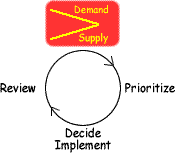Team-based forecasting
Overview
Use the team-based forecasting when your view of the future is fairly certain. Responding to corporate guidance, the team needs to motivate its group, focus on your customers and align around a specific goals. Each year, you update your assessments, forecast for the next few years, and prioritize to prepare your budget.
If you see the market changing quickly, you reconvene, adapt and shift resources. You want you key
players to be able to manage their organizations with a comprehensive understanding of where the business his headed in the future.
Your view of the future is clear. The key players and one or two highly innovative folks are on the team. The issues are first, how much stretch is needed and if things don't go well, when does the team need to step back and rethink the strategy. The planning horizon usually includes expensive, capital improvements.
You want everyone to understand big picture and their role in it. You want to present your strategic focus with a few key ideas, to motivate and inspire.
Most government strategic planning - local, state and federal - is team-based forecasting.
Skip ahead to go to the Meeting Chapter
for process details.
Objectives
"It is not chess or a formula on an Excel spread
sheet, its herding smart cats."
 Many expect a strategy to layout the explicit steps, like a game of chess. They want a formal, deliberate process with all facts, figures, and forecasts complete. Just plug those numbers in, and the strategy pops out of a magic box. It doesn't work that way. No one has the time or money to anticipate every outcome and even the best forecasts are seldom close. We can make reasonable estimates of the costs to build a building, even a space shuttle, but accurately predicting the future is still complex. When you figure out how to do that, you'll be so rich, you won't need strategic planning. Many expect a strategy to layout the explicit steps, like a game of chess. They want a formal, deliberate process with all facts, figures, and forecasts complete. Just plug those numbers in, and the strategy pops out of a magic box. It doesn't work that way. No one has the time or money to anticipate every outcome and even the best forecasts are seldom close. We can make reasonable estimates of the costs to build a building, even a space shuttle, but accurately predicting the future is still complex. When you figure out how to do that, you'll be so rich, you won't need strategic planning.
Rather, the leaders, all the way down to the department level, need an intuitive understanding of their organization, so they can work together like an experienced sports team. Before you implement, the key players
study - you can't avoid the study - pick a route, agree objectives and discuss the issues to the level of detail needed to prepare their
budgets. At the business unit and firm level, you have to plan how you will generate the funds to make the capital improvements, from cash flow from operations, debt or equity.
The leaders must manage the process and frame the challenges so everyone is motivated to learn and the environment fosters communication and innovation. That will be a challenge if your leadership expertise is more technical than working with people.
Why Call It Forecasting
Why do I call the process team-based forecasting with an emphasis on forecasting?
Most definitions of forecasting discuss
uncertainty.
In my military service, we frequently worked with high levels of uncertainty during strategic planning
and planned for many contingencies, many outcomes.
In strategic planning with top-down corporate guidance, most teams are asked to plan one or two
years into the future and to set team specific goals and objectives to align to corporate goals and
objectives.
The classic team strategic planning process assumes that there is history, data and enough confidence
to extrapolate into the future. The team is forecasting one outcome with confidence about the likely
outcome.
Steps
The team leader and a couple of key players identify the study areas and any outside assistance needed. They add members to ensure the right mix of innovative and efficiency folk.
 First, the team leader and key team members confirm the corporate vision and guidance. First, the team leader and key team members confirm the corporate vision and guidance.
Marketing develops external growth options, or the team leader estimates internal requirements.
The other folk examine demand side, the external world, for competitive forces and complementary opportunities.
The entire team assesses the firm's processes supply it products and services (its value chain) and employee morale.
The financial person does a historical trend assessment of cash flow and margins. Where are you in the product life cycle. At the department level, you compare your performance to industry benchmarks.
The team meets off-site to synthesize the assessments using a SWOT, agree the strategic focus, and prioritize the best options - often called that the privatization meeting.
Some team members prepare or revise the key documents you'll use to communicate your plan. Most will draft Action Plans, where you estimate the cash flow and the benefits for each option.
You reconvene; put your leadership hat firmly on; and decide the strategy, timing, resources needed and confirm responsibilities and coordination issues.
You may have to present your strategy to the decision maker for validation or approval.
If you are from government, the steps are the same, the language differs a bit.
 Bottom-up Bottom-up |
|
Team Membership  |
|